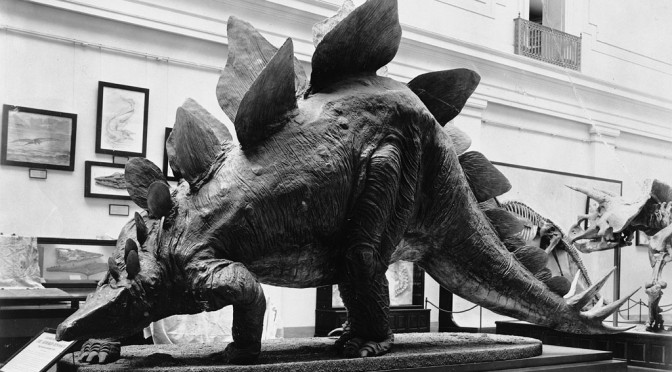By Ilja Nieuwland
Amsterdam may be known for a lot of things, but dinosaurs aren’t usually among them. However, take a walk along the central Plantage Middenlaan in Amsterdam’s Plantage (‘plantation’) district and you will be confronted by two unlikely-looking creatures in the city zoo’s gardens: one is instantly recognizable as Stegosaurus, the other is not quite as obviously a theropod of some description.
The Amsterdam zoo Artis* is one of the oldest in Europe. Founded in 1838 by the society Artis Natura Magistra (hence its colloquial name), it was originally only open to members. However, following the founding of Amsterdam’s university and changing ideas about the role of such societies in educating the masses, the zoo gradually opened its doors to a more diverse audience.
In 1906, the 12-year-old Boudewijn Bollee became a keeper of animals at the zoo. Initially hired for menial work, he quickly showed an aptitude for handling animals, particularly reptiles, and established himself as the overseer of the reptile house. Bollee was also a bit of an artist though, and he set about decorating the zoo grounds with his sculptures, usually of reptiles. Most of these can still be seen, such as this chameleon:
By the early 1950s, however, Bollee had set out on a more ambitious project: the reconstruction of prehistoric reptiles on a patch of land along the Plantage Middenlaan, where they might be admired both from within the zoo and outside.
The first of these, a Stegosaurus, clearly drew inspiration from the papier maché sculpture that had been on display at the Smithsonian from the 1900s through to the 1960s. Bollee crafted the animal between May 1952 and March 1953; it was constructed by using a chicken wire mesh on a steel frame, which was then covered in concrete. The construction needed to be solid, but also cheap: these were the immediate post-war years, and keeping cost and the use of materials down remained an important priority. For that reason also, the animal’s length was limited to six meters instead of nine; but, according to its maker, that had also been done in order to ‘not cause a solar eclipse’.
After Stegosaurus, Bollee set out on his wildest project: the reconstruction of a ‘Tiranosaurus‘ (as a newspaper of the day called it). Where the Stegosaurus had been pretty much a private initiative, for the second dinosaur Bollee received more assistance. A workshop was put at his disposal, and the zoo gave him time to work on the project, which was unveiled on May 1, 1954. Bollee did not survive his largest creation by much: in 1956 he passed away, months after the anniversary of his 50 years in the zoo’s service.
Looking at the animals with modern eyes, we have to say that the Stegosaurus is the most successful of the two, partly because Bollee could work from a good example, but also because in recent times, the general image of stegosaurs has changed far less than that of theropods. The oedemic-looking, martyrial stance of the animal doesn’t help of course; nor do some no anatomical inaccuracies, such as the three-fingered hand. In Bollee’s defence: this was also a structurally much more challenging sculpture, because of its greater size and less self-evident weight distribution.
For nearly six decades, these animals have now been part of the Amsterdam cityscape. The zoo’s initial penny-pinching meant they needed to be restored in the early 1990s, but since they’re protected landmarks now, they may astonish future generations. Indeed, walking around near the zoo I observed a metal exhibit that suggests at least some affinity with the nearby sculptures. Dinosaurs apparently continue to proliferate in Amsterdam; I’m sure Bollee would have been delighted.
Photo: Branko Collin.
References:
- Kruizinga, J.H., “Ter Herinnering Aan Oppasser B. Bollee.” Ons Amsterdam 9, no. 8 (1957): 249-252. Local newspaper obituary of Bollee.
- Donna C. Mehos, Science and Culture for Members Only: The Amsterdam Zoo Artis in the Nineteenth Century (Amsterdam: Amsterdam University Press, 2006). Extensive history of the zoo, based on the author’s Ph.D. thesis.
Thanks go out to Marieke van der Duin and Peter van Mensch for sharing.






